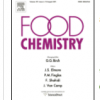
Autores:
Alejandra Carreon-Alvarez
Azucena Herrera-Gonzalez
Norberto Casillas
Rogelio Prado-Ramirez
Mirna Estarron-Espinosa
Victor Soto
Wencel de la Cruz
Maximiliano Barcena-Soto
Sergio Gomez-Salazar
Revista y/o libro:
Food Chemistry
Volumen:
127
Año:
2011
Sinopsis:
An ion-exchange resin was employed to remove copper from tequila. Elemental analysis, batch and column copper uptake measurements were performed to assess the extent of metal removal; FTIR and XPS were employed to elucidate the copper complexes formed on the surface of resin; GC was used to investigate resin fouling and the extent of methanol removal. A modified Langmuir isotherm was used to explain adsorption equilibrium data. A ligand density of 2.21 mmol/g as sulphonic group, was measured. Maximum copper uptake by resin was 0.59 mmol/g. GC results from column experiments revealed methanol changes from 311 mg/100 ml anhydrous alcohol (AA) to 212 mg/100 ml AA, complying with Mexican regulations. Tequila solution with copper (5.3 l, 7.3 mg/l) was treated to breakthrough point in column experiments reaching 0.5 mg/l of copper at effluent. These results comply with the Mexican regulation for copper concentration (⩽2 mg/l) showing the promise of resin for industrial applications in removal of copper and methanol from tequila